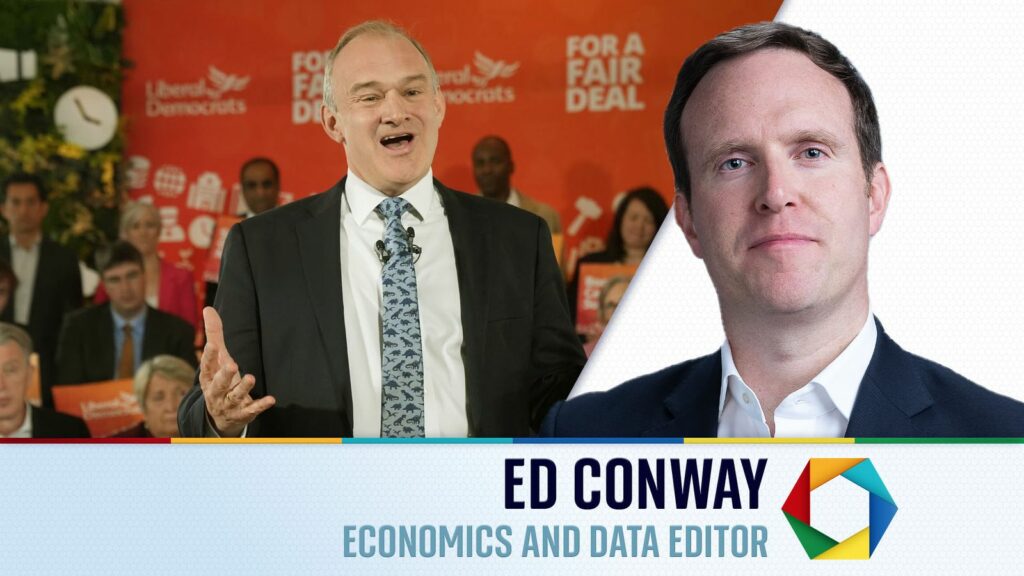Why Liberal Democrats’ manifesto is far less ambitious than the previous one | Politics News

First things first, if you’re wondering whether the sums in the Liberal Democrat manifesto add up and – to adopt the phrase that leader Sir Ed Davey used rather a lot today – are “fully costed”, the answer is: well, yes, sort of.
If you have full faith in all the numbers published in the costings document published alongside the Lib Dem manifesto, then they are indeed fully-funded. For the £27bn or so of extra spending commitments is paid for with the £27bn or so of extra taxes and money raising. Hurrah!
Except that it’s not so simple, because it’s not altogether clear we should have full faith in those numbers.
General election live: Follow the latest updates
Please use Chrome browser for a more accessible video player
1:28
Davey ‘touched’ by care messages
To take one example: the Lib Dems say they’re planning to raise £3.62bn (note the two decimal places) by reforming aviation taxes. Yet when you ask what level they’re actually planning to increase aviation taxes to, they don’t have an answer. They want to raise a certain amount of money; they just haven’t got a detailed plan for precisely how to raise that amount of money.
Or take their plans to tax share buybacks. It’s very likely that this would raise nowhere near the £1.4bn they think it will – in large part because most companies will simply change their behaviour in the face of the new tax.
Then there’s the fact that the main revenue raiser in the Lib Dem manifesto is actually not a new tax at all, but the assumption that they will be able to squeeze tax avoiders even more than the last lot, raising an extra £7bn in the process. Lib Dem party officials say this ambitious number (higher than the £5bn Labour think they could make of the £6bn from the Tories) will be achieved by investing £1bn in HMRC processes. It would be nice if this succeeded; but it’s not altogether clear it will.
These are hardly the only question marks. I’m a little sceptical that the Lib Dem plan to solve the asylum crisis, allowing asylum seekers to work after three months, would really bring in a whopping £4.3bn, as the costings document implies.
This content is provided by Spreaker, which may be using cookies and other technologies.
To show you this content, we need your permission to use cookies.
You can use the buttons below to amend your preferences to enable Spreaker cookies or to allow those cookies just once.
You can change your settings at any time via the Privacy Options.
Unfortunately we have been unable to verify if you have consented to Spreaker cookies.
To view this content you can use the button below to allow Spreaker cookies for this session only.
Allow Cookies Once
👉 Tap here to follow Politics at Jack at Sam’s wherever you get your podcasts 👈
Authorities like the Nuffield Trust question whether the health and social care spending increase factored in in this manifesto (£8.4bn – or about £10bn when you include the promise to reward unpaid carers) will make much of a difference. They say it will equate to real terms increases well below the long-term average.
Then there’s the bizarre case of the missing net zero investment. Back in 2019, the Lib Dems committed to achieving net zero carbon emissions by 2045 rather than 2050, and said they would invest £86bn to do it. This time around, the manifesto commits, once again, to hitting net zero by 2045, but it only promises to spend a mere £8.4bn in the process. And no, that decimal place really is in the right place.
Read more:
Lib Dems pledge to ‘end hospital crisis’ with free personal care
Davey admits falling in on purpose for election stunt
Please use Chrome browser for a more accessible video player

8:57
£2 hourly rise for care sector
Perhaps you think this is nitpicking. And in fairness, all the major parties play similar games around election time. In the absence of an institution like the Office for Budget Responsibility marking each party’s workings, they can get away with broad brush back-of-envelope sums like this.

Keep up with all the latest news from the UK and around the world by following Sky News
Tap here
Perhaps the most instructive takeaway from today’s manifesto is to note that it is far, far less ambitious than the one that preceded it. When Jo Swinson was Lib Dem leader back in 2019, her manifesto involved spending plans of roughly £63bn a year. The spending plans in today’s manifesto are basically half that size – even less once you adjust for inflation.
Whether you conclude that’s down to the times we’re living in, with the public finances more constrained, or it’s because the Lib Dems have changed considerably since then – it’s certainly a less radical vision than last time around.

Recent Comments